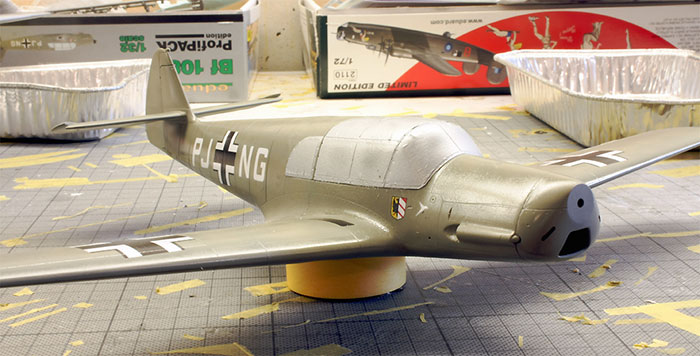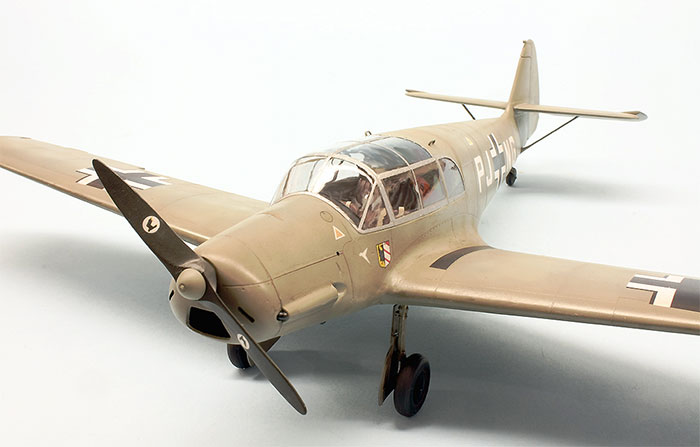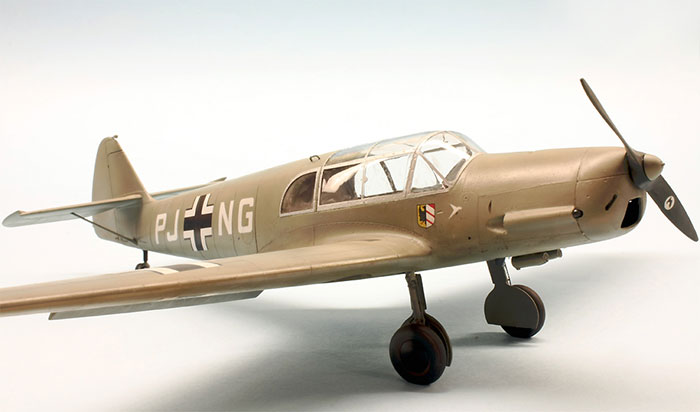Eduard's 1/32 scale
Messershmitt Bf 108
PJ+NG
by Roland Sachsenhofer

As soon as the terms "Messerschmitt" and "Battle of Britain" are mentioned together, then in most cases one type of aircraft is the subject of discussion: the Bf 109E. As the only single-engined fighter on the German side against the British Spitfire and Hurricanes, the 109 became one of the icons of this decisive struggle for air supremacy over the Channel.
Less present in our minds, however, are those aircraft that have performed no less vital service as courier or VIP transport aircraft in the second row. Such an example can be seen in my present model, which was used as a liaison aircraft in the summer of 1940 from the I Group of JG 54 in the west of France.

The chain of associations "Messerschmitt" and "Battle of Britain" may thus be enriched by one type: the Bf 108 Taifun! In its class, the Bf 108 is no less a legend than the 109th Bf 108. It is not only epoch-making for the Messerschmitt AG company history, but also occupies a special place in the history of technology as the first all-metal aircraft in half-shell construction.
The development histories of the Bf 108 and the Bf 109 are intertwined in many ways. The experience gained in the design and testing of the four-seater touring aircraft enabled Willy Messerschmitt to successfully participate in the tender for a new fighter for the upgrading Luftwaffe the following year. Even against the record-breaking He-100 of the experienced manufacturer Heinkel, the design of the "newcomer" Messerschmitt prevailed.
How can this be explained? The design of the Bf 108 Taifun was - typical for Messerschmitt - uncompromisingly and inventively designed for weight reduction. The metal fuselage half-shells, for example, are inherently rigid and give the construction strength without the need for an internal support structure. A system of automatically extending slats and generously dimensioned landing flaps enabled the wings, which were designed for high cruising speeds, to be adapted to the slow flight ranges during take-off and landing. Last but not least, another novelty for the time: a slim, outwardly retracting landing gear with one-piece struts further rounded off the aerodynamically clean exterior.

It is not without reason that the Bf 108 and the 109 look so similar, since Messerschmitt's classic fighter has inherited all these technical features from its closest relative. If you look at the following series of Messerschmitt designs such as the Bf 110, Me 410 or even the Me 262, you will find all these technical characteristics again. Who could deny that the Bf 108 was a highly interesting aircraft whose design truly made history?
The markings for the Bf 108 PJ+NG come from the Profipack kit, which Eduard has issued this year. They use moulds that had been developed by a manufacturer called "Striped Fighters" who has since disappeared from the market. The Taifun is the only kit developed by this company, apparently the already finished injection moulded parts were taken over by Eduard and marketed under his own name.

The quality of the plastic parts is outstanding: accuracy of fit such as precision and sharpness of the castings leave nothing to be desired, and the model maker is also delighted with the model's construction thanks to a well thought-out and unpretentious approach.
Eduard meets the Profipack nature by adding cover masks and etched parts for detailing the cockpit and individual parts of the exterior. The lone resin part is a representation of the wooden propeller required for some versions. This is where my only criticism comes in, but I may say that it could have been caused by my own carelessness: the wide cast-on part of the resin block running over a good part of the total length makes it difficult to separate the filigree propeller. I broke it promptly, but thank God I was able to glue and sand it down again without scarring. So here I would like to call for caution.

Finally a rather amusing experience, for which I have not found an explanation yet: while assembling the fuselage half-shells I applied the usual glue on both sides, carefully brought the fuselage parts without register pins together, aligned them precisely and then released them from the holding grip of my hands. To my amazement, however, both parts fell apart without even the appearance of adhesion. In short: the conventional adhesives from Tamiya or Revell that melt the plastic did not work and after several more attempts were not used for further construction. As a consequence the Bf 108 were finished like a kit made of resin with CA-glue. I will be interested to know if this surprising feature only occurred in my own model or if other kits of the Bf 108 of this series are affected by it as well.
The completion of the Bf 108 Taifun in 1/32nd scale concludes for me a quite interesting examination of this impressive and also influential aircraft type, which has resulted in the construction of four models of the Bf 108. Each of the models shows the potential that Messerschmitt had in this design. Just like Eduard's own developments in 1/48th scale, I can also warmly recommend this model kit in large scale!
If you are interested in the building process, please have a look here on Scalemates:
https://www.scalemates.com/profiles/mate.php?id=10148&p=albums&album=63042
As ever, remarks will be appreciated: ro.sachsenhofer@gmx.at
Model, Images and Text Copyright ©
2020 by Roland Sachsenhofer
Page Created 2 December, 2020
Last Updated
2 December, 2020
Back to HyperScale Main Page

|
Home
| What's New | Features | Gallery | Reviews | Reference | Resource Guides | Forum |